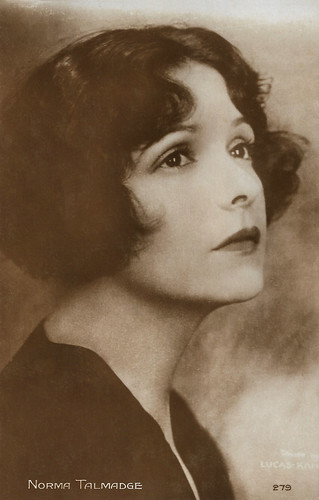
French postcard by Editions Cinémagazine, no. 279. Photo: Lucas Kanarian.
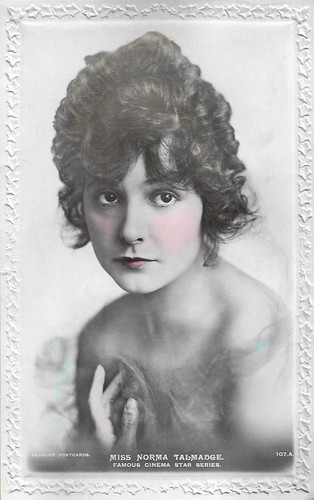
British postcard in the Famous Cinema Star series by J. Beagles & Co. Ltd., no. 107. A.

British postcard. Caption: Norma Talmadge, Gaumont "Select Pictures" Star. Gaumont must refer to the distribution and not the production company, as Talmadge did not act in films produced by Gaumont. Select Pictures was an American company run by Lewis J. Selznick and Adolph Zukor and was active between 1917 and 1923. Select Pictures Corporation was formed when Adolph Zukor acquired 50 percent ownership of Selznick Pictures Corporation. Selznick later bought back the company and changed the name back to Selznick Pictures Corporation. The company went bankrupt in 1923.
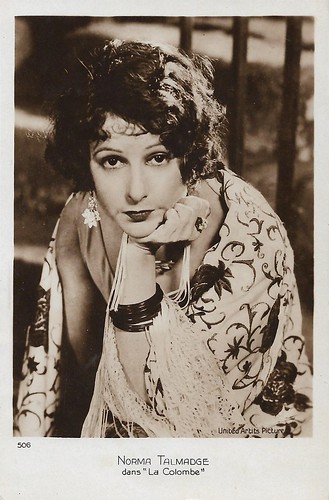
French postcard, no. 506. Photo: United Artists. Publicity still for The Dove (Roland West, 1927). The French title is La Colombe.

Italian postcard by Casa Editrice Ballerini & Fratini, Firenze, no. 93. Photo: United Artists.
Abandoned by her alcoholic and jobless father on Christmas Day
Norma Marie Talmadge was born in 1894 in Jersey City, New Jersey. She was the daughter of one of the most famous 'mothers of artists' in film history: Margaret 'Peg' Talmadge, the prototypical Hollywood stage mother.
Norma, her mother Peggy and her sisters Natalie and Constance Talmadge were abandoned by the girls' alcoholic and jobless father Fred Talmadge right on Christmas Day. Her mother took in laundry to help make ends meet, and the three teenagers had to start earning money as vaudeville models and actresses.
In 1909, Norma began working in the cinema thanks to her discoverer, Vitagraph editor Breta Breuill. She landed a small role in The Household Pest (1910).
With her mother's prodding, she landed more small roles in numerous Vitagraph shorts, a.o. Uncle Tom's Cabin (J. Stuart Blackton, 1910) with Florence Turner, Love of Chrysanthemum (Van Dyke Brooke, 1910) with Maurice Costello, and A Tale of Two Cities (William Humphrey, 1911).
Helped by Vitagraph leading actor Maurice Costello, her career blossomed. By 1913, she was the major star of Vitagraph Studios and played in hundreds of shorts there. Her co-actors from the Vitagraph 'stable' were a.o. Van Dyke Brooke, Lilian Walker, Hughie Mack, Leo Delaney and Clara Kimball Young.

Finnish postcard by Korttiekeskus Kortcentralen, no. 10. Constance, Norma and Natalie Talmadge with their mother Margaret. Collection: Marlene Pilaete.
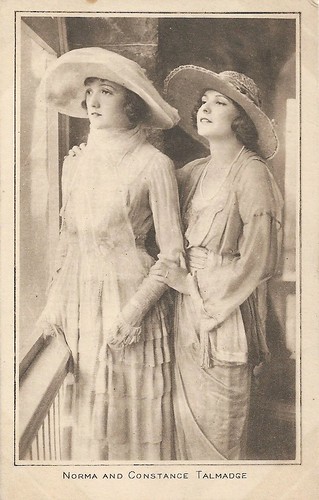
With sister Constance Talmadge. British postcard in the 'Pictures' Portrait Gallery by Pictures Ltd., London. Photo: Puffer.
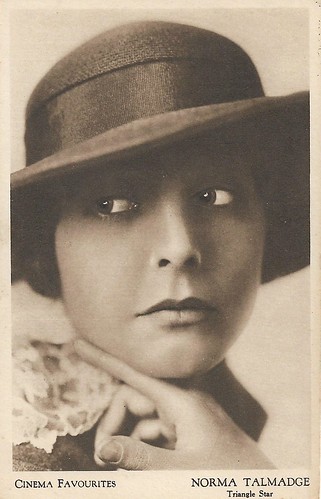
British postcard. Cinema Favourites was a series of Photochrom Co. Ltd. of London, in collaboration with the American film company Triangle Pictures.
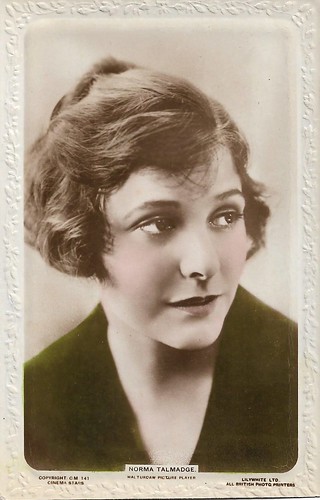
British postcard in the Cinema Stars series by Lilywhite Ltd., no. CM 141. Photo: Walturdaw Pictures. Walturdaw was an early British film production company which stopped filming in 1911, continuing as a film distributor until 1924. So this card refers to the years 1911-1924.
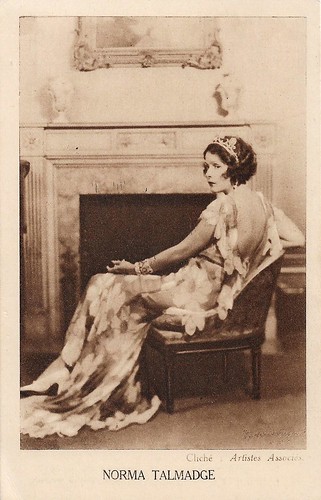
Dutch postcard by De Faam, P.A. De Bont's Fabriek van Chocolade en Suikerwerken, Breda. Photo: Artistes Associés (United Artists).
Smitten by her, Schenck proposed marriage and a studio
In 1915, Norma Talmadge had her breakthrough when she acted in Vitagraph's anti-German propaganda film, the feature The Battlecry for Peace. But, Mother Talmadge was unsatisfied with Vitagraph and arranged a two-year contract at National Pictures. In August of 1915, Norma and her mother left for California and the promise of success in the fledgling film industry there.
Yet, Norma's first film there, Captivating Mary Carstairs (1915) flopped, and National Pictures went bankrupt. During this time her sister, Constance Talmadge, was working for legendary director D.W. Griffith. Constance managed to get Norma a contract with Griffith's film studio Triangle. Over the following eight months Norma made seven feature films and a few shorts for Triangle. After the contract ran out, the family returned to the East Coast.
In 1916, Talmadge met and married Joseph M. Schenck, a wealthy exhibitor who wanted to make films himself. Smitten by her, Schenck proposed marriage and a studio. They founded the Norma Talmadge Film Corporation.
In Schenck's New York-based studio, Norma would act in her dramas on the ground floor, while her sister Constance Talmadge would do comedies on the first floor, and the comic unit with Fatty Arbuckle played on the top floor, while sister Natalie Talmadge worked as a secretary and occasionally had small parts as well.
Fatty Arbuckle brought along his colleagues Buster Keaton and Al St. John. When Arbuckle was lent to Paramount to do features, Keaton took over the comic unit and married Natalie.
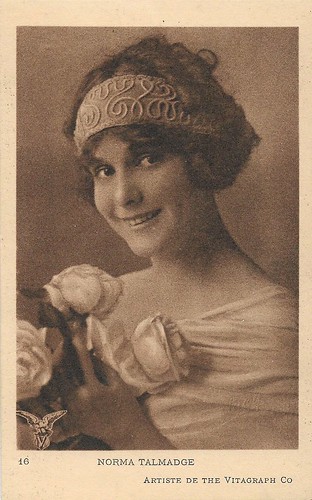
French postcard. Caption: Norma Talmadge, artist of The Vitagraph Co., no. 16. In contrast to most American film companies, who had London as their hub for the European film distribution market, Vitagraph had opened an office in Paris and arranged its European publicity from there, including the astonishing film posters (de)signed by Harry Bedos. Between 1909 and 1915 Norma Talmadge was one of the regular actors at Vitagraph, acting in hundreds of shorts, but also in the feature The Battlecry for Peace (J. Stuart Blackton, Wilfrid North, 1915).

French postcard in the Les Vedettes de l'Ecran series by Editions Filma, no. 73. Photo: Puffer / Norma Talmadge Film.
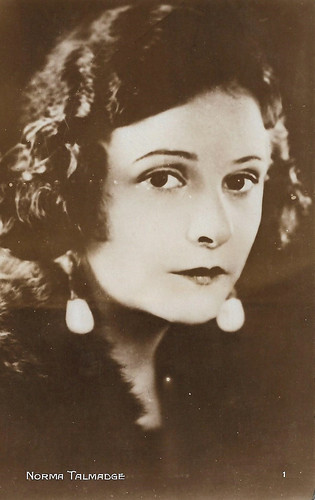
French postcard by Editions Cinémagazine, no. 1. Photo: Royal Atelier, N.Y. This is the first postcard of the vast series of film star postcards issued by the French film journal Cinémagazine.
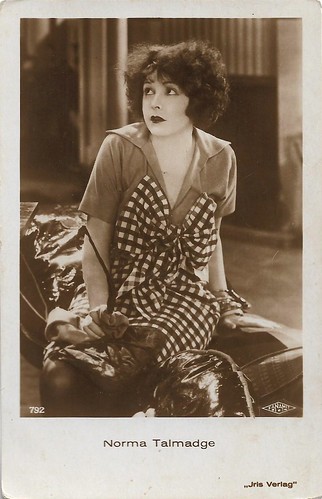
Austrian postcard by Iris Verlag, no. 792. Photo: Fanamet.

American postcard by Max B. Sheffer Card Co., Chicago (M.B.S.C.Co.). Photo: First National. Norma Talmadge as Monyeen in Smilin' Through (Sidney Franklin, 1922).

American postcard by California Postcard Co, Los Angeles/ Photo: Glen G. Stone, Los Angeles. Norma Talmadge at United Studios, Hollywood. Caption: Off-stage view of Norma Talmadge, who is here seen receiving a suggestion on 'make-up" from Frank Lloyd, her director.
She fell in love with her co-star and asked Schenck for a divorce
Norma Talmadge's first film at her own studio, Panthea (Allan Dwan, 1917) was a straight hit. Between 1917 and 1921, Norma made four to six films per year, under Joseph Schenck's supervision.
After her greatest success, the drama Smilin' Through (Sydney Franklin, 1922), Schenck closed the New York studio. The family continued in Hollywood, where Norma's films became bigger and glossier.
She worked with top directors, cinematographers and costume designers and by 1923 she was the best-paid film actress in Hollywood, earning 10.000 dollars a week. In 1924 under Frank Borzage's direction, she did her best film - artistically and at the box office - Secrets (Frank Borzage, 1924).
While Schenck became head of United Artists in 1924, Norma was still tied to distributor First National by contract and continued to make films for them in the mid-1920s, including Camille (Fred Niblo, 1926).
During the filming of Camille, she fell in love with her co-actor Gilbert Roland and asked Schenck for a divorce. Schenck refused the divorce but saw Talmadge and Roland were a winning couple and matched them in several films. After that, she made films with United Artists, but the first two were flops.

Spanish collectors card by Chocolate Amatller. 1920s. Series QQ, Artist 58, no. 107. Norma Talmadge and Lowell Sherman in Yes or No? (Roy William Neill, 1920).

Spanish collectors card by Escenas selectas de cinematografia, Serie A, no. 16. Photo: Norma Talmadge Film. Norma Talmadge, Harrison Ford, and Howard Truesdale in The Wonderful Thing (Herbert Brenon, 1921), presented in Spain as 'La princesita del jamón' (The Ham Princess).

Spanish collectors card by Escenas selectas de cinematografia, Serie B, no. 16. Norma Talmadge and Conway Tearle in The Eternal Flame (Frank Lloyd, 1922).

Italian postcard by G.B. Falci, Milano, no. 326. Photo: Esclusiva S.A. Stefano Pittaluga. Norma Talmadge in Camille (Fred Niblo, 1926), produced by Talmadge's own film company and distributed by First National. The film was based on the often filmed novel and stage play 'La Dame aux Camélias' (The Lady of the Camellias), both by Alexandre Dumas, fils. Stefano Pittaluga distributed the film in Italy. The man next to Talmadge could be Oscar Beregi, who plays the Count, or Harvey Clark, who plays the Baron.
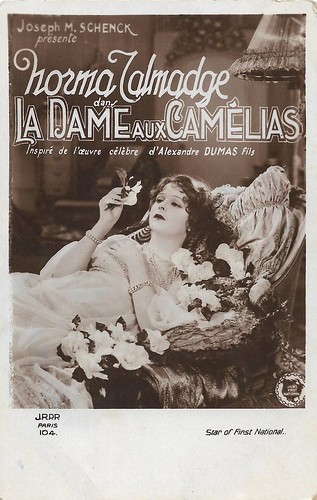
French postcard by J.R.P.R., Paris, no. 104. Photo: First National. Publicity still for Camille (Fred Niblo, 1926). Produced by Joseph Schenck, the later producer of United Artists, and based on the famous novel by Alexandre Dumas fils.
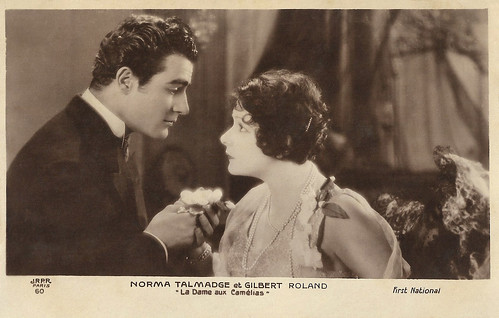
French postcard by J.R.P.R., Paris, no. 60. Photo: First National. Publicity still for Camille (Fred Niblo, 1926) with Gilbert Roland.
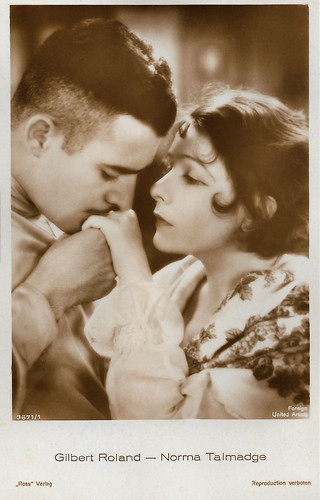
German postcard by Ross Verlag Foreign, no. 3671/1, 1928-1929. Photo: United Artists. Publicity still for The Woman Disputed (Henry King, Sam Taylor, 1928) with Gilbert Roland.
Falling on wet cement in front of the Grauman's Chinese Theatre
By 1928, Norma Talmadge's popularity had begun to fade. Her final silent film, The Woman Disputed (Henry King, Sam Taylor, 1928), was a flop at the box office. By that time sound film was all the rage. Norma took voice lessons for a year, and despite expectations, produced a perfectly non-dialectical voice.
Her first two sound films, New York Nights (Lewis Milestone, 1929) with Gilbert Roland, and Du Barry, Woman of Passion (Sam Taylor, 1930) with William Farnum and Conrad Nagel, simply weren't so good. So she called it a day and left the film world
As Talmadge was very rich by now, she could permit herself to do so. In 1927, Norma and her sisters opened the Talmadge Park real estate development in San Diego, California, USA. Now known as the Talmadge district, the development contains streets named for each of the sisters.
Norma Talmadge and Joseph M. Schenck divorced in 1934, but Schenck continued to act as her financial adviser and guided her business affairs. In 1934, she married her second husband, George Jessel, who eagerly brought her on his ailing radio shows. She thought this might be the vehicle by which she would revive her stalled film career, but the show continued its decline and was ultimately cancelled and with it the hopes of rebuilding her shattered career. She divorced Jessel in 1939.
Norma married for the third time in 1946, Dr. Carvel Musser James. She remained with him until she died of a stroke or pneumonia (the sources differ) on Christmas Eve of 1957 in Las Vegas, Nevada. She was 64.
It is said that we owe to Norma Talmadge the tradition of stamping the handprints of the stars in front of the Grauman's Chinese Theatre, when in 1927, accidentally, she left her own when falling on wet cement in the same place.
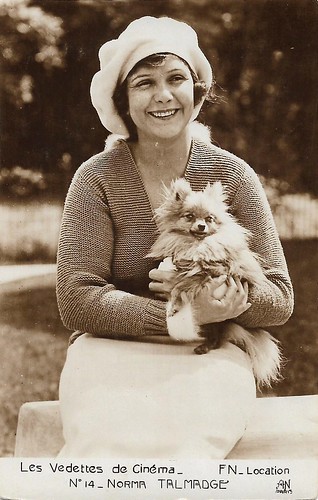
French postcard in the Les Vedettes de Cinéma series by A.N., Paris, no. 14.
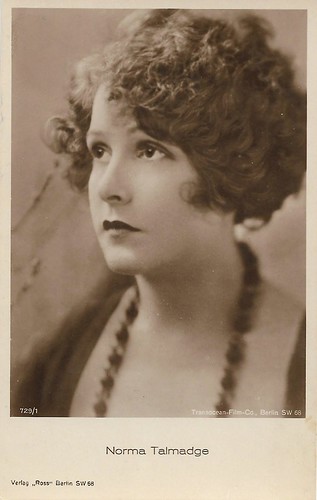
German postcard by Ross Verlag, no. 729/1, 1925-1926. Photo: Transocean-Film-Company, Berlin.

German postcard by Ross Verlag, no. 1472/1, 1927-1928. Photo: United Artists.
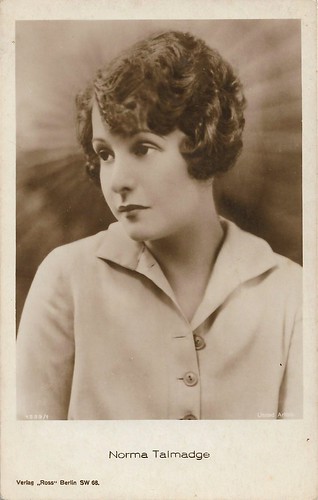
German postcard by Ross Verlag, no. 1539/1. Photo: United Artists.
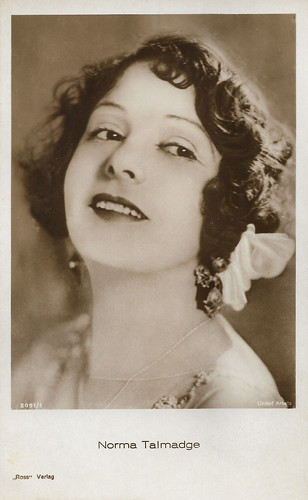
German postcard by Ross Verlag, no. 2091/1, 1927-1928. Photo: United Artists. Publicity still for The Dove (Roland West, 1927).
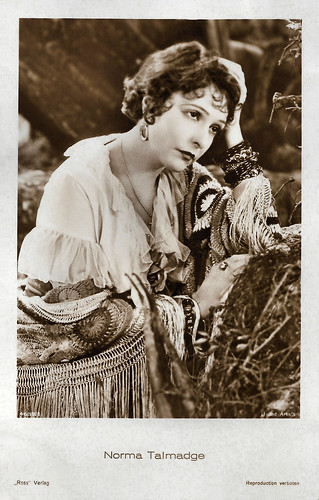
German postcard by Ross Verlag, no. 4639/1, 1929-1930. Photo: United Artists. Publicity still for The Dove (Roland West, 1927).

German postcard by Ross Verlag, no. 5306/3, 1930-1931. Photo: United Artists. Norma Talmadge in Du Barry, Woman of Passion (Sam Taylor, 1930).
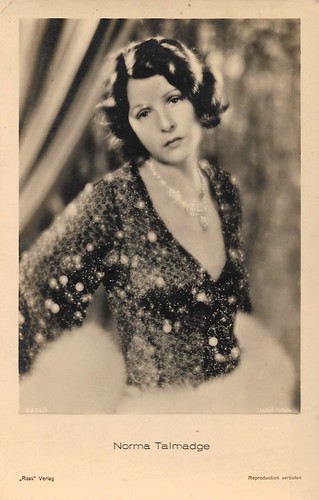
German postcard by Ross Verlag, no. 5866/1, 1930-1931. Photo: United Artists.
Sources: Denny Jackson (IMDb), Wikipedia (English, Dutch and Spanish) and IMDb.
No comments:
Post a Comment